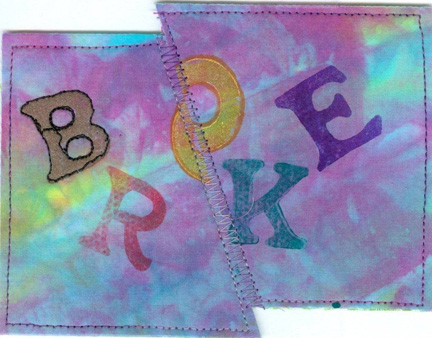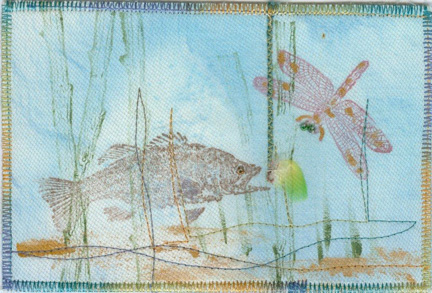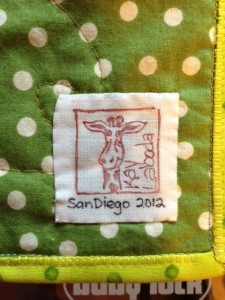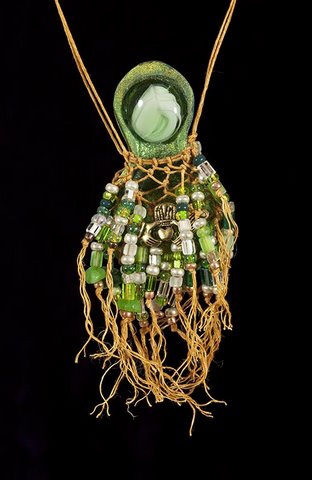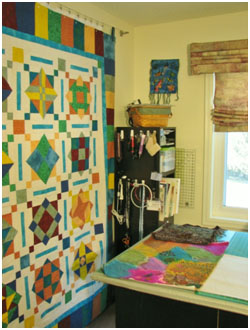Monthly Archives: March 2012
Featured Artist: Vivian Helena Aumond-Capone
Vivian Helena is a mixed media fiber/quilt artist who loves to work with gourds and jewelry. “I am easily distracted with the next project, and have many going at one time. I have been teaching fabric dyeing and beginning gourd art for many years. I am blessed with my own home studio.” Her website is http://www.vivianhelena.com/.
1. Tell me a little about yourself
Most of my inspirations transpire in mixed media fiber art. Gourds, jewelry and photography also hold a fascination for me. We live in the rolling hills near Yosemite National Park on the Fresno River. When living in the middle of nature, you are a part of the changes that happen on a daily basis. Each morning sees the excitement of the day– birds in the trees, animals wandering by, the smell of pines and oaks, and the breeze that flows up the river. It is a great way to start the day.
2. Why did you join Postmark’d Art? When did you start making postcards?
I joined Postmark’d Art six years ago, after looking around on the net, thinking this would be a fun way to experiment with different products and to stray from perfect quilting techniques. I also wanted to share and get to know ladies from other areas of the country. Little did I know that I would find dear friends in Australia, New Zealand, and Europe.
3. How do you display your postcards?
The postcards from the exchanges are set around in my house so that they can be enjoyed. Eventually I place them in white binders for safekeeping. Periodically, they are taken out to share for a lecture or to share during teaching for ideas.
4.What have been some of your favorite themes?
Each session we have many themes to choose from and some of my favorites are Steampunk, Floral, Seasons, and Hearing. Usually themes that make me stretch for the ideas are my favorites.
5 .Tell me about your interests.
We have four llamas, and seven outdoor cats. I love gardening, reading, hand embroidery and simple knitting. I have too many UFO’s in knitting also. Volunteering takes up a bit of my time, I volunteer at the Coarsegold Historical Society, P.E.O., Timberline Co-op Gallery, and Sierra Mountain Quilters Society.
One of the special benefits of Postmark’d Art is the fantastic ladies that I have been blessed to meet. When we are stuck with a creative idea or need help with a project we can count on each other to lend an ear and someone will always know how to work with a new product. All are sharing and understanding. Everyone’s life has some tough moments and celebrations. We share these moments by giving our support. This is a special family.
Ladies With Chops
Seal carving, or stamp engraving, is traditionally listed as one of the Four Arts in China. A seal/stamp, also known as a chop, was for many centuries a symbol of power: emperors used it to give orders, officials used it on official documents, and civilians used it as a signature.
Late last year there was quite a buzz among the group about chops. As often happens, a flurry of activity ensued. The first activity that many members engaged in was a search for their own chop. Here are the chops that were ‘rediscovered’ and brought back into circulation:
Vivian Aumond-Capone purchased her chop in the 1980’s while taking a Chinese Brush Painting class with Ning Yeh in Huntington Beach, California. The chop has not been found yet, but here is a photo which shows it in use.
Vivian was told that one of the words on the chop means “beauty.” The hunt for the chop will continue but she is considering purchasing a new chop, perhaps with her initials on it.
Sara Kelly purchased her chop in China. She shared the story of obtaining it with us: “In 2006 I went to China and tour bus guide in Beijing said she had a cousin who carved chops. Thus she could get us a great deal and they would be ready by the end of the day. We carefully printed our full names and birth year and went on our way to the Great Wall. I ordered one for each of my sons and one for myself. As promised, they were ready that evening. Each chop was nestled in a silk box with a ceramic pot of red ‘dragon’s blood’ ink. Although I was born in the Year of the Boar, mine is carved with an impressive dragon head. It is five inches long and prints an image 1.5 inches square.
Over the course of the following year I created a series of small journal quilts about my trip to China and used the chop on the label of each one. I’ve learned that the ‘dragon’s blood’ doesn’t print well on fabric, but in the interest of authenticity, I keep trying till I get a decent image. Like so many delightful little tools in my studio, it has been buried for a while and I appreciate this opportunity to resurrect my chop.”
Franki Kohler was inspired to buy a chop. Her shopping trip was shared here.
Kay Laboda drew the design she wanted and had it created as a stamp through an on-line source. “I rather like the sweet little guy,” says Kay. Can you tell she is partial to giraffes?
Karin McElvein purchased her chop for about $10 during a trip to China in 2001. She was visiting a temple when the opportunity presented itself. “I had forgotten until I found it that he had actually carved my name. I’m going to start using it on all my postcards!”
Sandy Wagner bought her chop during a trip to China in 1997. It was hand carved for her while she shopped at a very friendly store. It’s a bit difficult to read, she says, but “Sandy” is carved in English with Chinese characters under that. Perhaps she’ll carve it a little deeper to make it easier to read. It’s been about a year since she has used it.
Lynn Woll grew up living overseas. Her chop was made for her during 1967-68 while living in Seoul, Korea. Her maiden name is ‘Hand’ and the characters are a phonetic spelling of her name, Lynn Hand. “Funny,” says Lynn, “I hadn’t thought about it in years. When the conversation among the group started I went in search of it. Believe it or not, it was the in first place I thought I might have ‘safely put it away!’ Thanks for bringing back wonderful memories of living in Seoul with my family.”
A couple web sites were found that might be of interest. This one shows you how to make your own chop:Moo-Cow Fan Club.
This site will create your custom chop: Char4u.
More Green!
Happy St. Patrick’s Day
Wordless Wednesday: Wearin’ Green
Vivian’s Work Featured in Showcase 500 Beaded Jewelry
Our own Vivian Helena Aumond-Capone has landed in Showcase 500 Beaded Jewelry with one of her original designs.
Here’s a partial description of the book:
“This beautiful and inspiring book gathers photographs of 500 of the most breathtaking beaded jewelry designs created in recent years. The techniques the beaders employ are as varied as the aesthetic sensibilities they bring to their gorgeous creations and include beadweaving in every stitch imaginable, embroidery, quilling, loom weaving, and kumihimo braiding, as well as basic stringing, simple wirework, and fine metalwork. Sometimes, a bead maker’s focal piece simply is set in a straightforward, unpretentious, and beautiful design.
Every beader, jeweler, and crafter will want Showcase 500 Beaded Jewelry in their collection.”
The book’s publish release date is August 7, 2012 and is available for preorder through Amazon.com now.
Learn what else Vivian is up to at her blog.
Karen Musgrave’s Book is Out!
Quilts in the Attic: Uncovering the Hidden Stories of the Quilts We Love is available now. Or you can purchase an autographed copy from Karen.
As both history and art, quilts help express the human experience and can lead quilters to discoveries about themselves, about the past, and about artistic creation as a whole. Quilts in the Attic features 30 heartwarming stories of great quilt discoveries—from bidding on a breathtaking quilt at an estate auction in Virginia to uncovering a little-known art form in France to finding and repairing a priceless heirloom quilt that had been used, neglected, and damaged, these stories from everyday stitchers and well-known quilters alike reveal the mystery and meaning of the quilts we love.
First Friday Studio Tour – Janet Hartje
This month we travel to Woodbury, Minnesota to visit with Janet Hartje.
Do you call it a studio or sewing room? Why do you think this is so? Difference in starting point between quilting and art? Thinking of this as a business rather than a hobby?
I used to call it my craft space because I tend to do more than sew. The past few years I have begun to think of myself as a professional. Visualize what you want and it will happen, right? Subconsciously you will work toward your goals. Think it. Be it. Have it.
My studio was originally the formal dining and living room space. Shortly after we moved in the dining room became my space (almost 25 years ago!). When I purchased a longarm quilting machine three years ago the living space was added to my studio.
 In recent years I’ve joined several organizations and through them I have learned a great deal about Fiber Art. I didn’t realize Fiber Art involved such a wide range of activities and was such fun or I’m sure I would have joined these groups sooner. My passion right now is the Art Quilt. I enjoy everything from visualizing the design, to controlling the color and pattern of the fabric, to the tiny embellishments that finish it. When I create my Fiber Art quilts, or postcards, I work in my studio to have access to as many materials and pieces of equipment as possible.
In recent years I’ve joined several organizations and through them I have learned a great deal about Fiber Art. I didn’t realize Fiber Art involved such a wide range of activities and was such fun or I’m sure I would have joined these groups sooner. My passion right now is the Art Quilt. I enjoy everything from visualizing the design, to controlling the color and pattern of the fabric, to the tiny embellishments that finish it. When I create my Fiber Art quilts, or postcards, I work in my studio to have access to as many materials and pieces of equipment as possible.
What do you have in the room?
A Bernina 185E is my primary sewing machine. It replaced a Kenmore that I loved — a gift from my husband on our first anniversary. He knew even then, some of my favorite gifts involve sewing and craft items. I still have that machine but after being dropped by a repairman it has never worked quite the same. For our 25th anniversary my sweetie gave me a Bernina. I know most women want jewels but to me a new sewing machine was much better than jewelry.
 My cutting table is two back-to-back IKEA cabinets with a covered board on the top. These cabinets hold plain white and black fabric which I hand dye, bleach or print. I also store tools for making rubbings, prints or sun dyeing fabric, specialty fabrics I use with my embellisher, interfacing, Misty fuse, peltex and some specialty papers for mixed media projects.
My cutting table is two back-to-back IKEA cabinets with a covered board on the top. These cabinets hold plain white and black fabric which I hand dye, bleach or print. I also store tools for making rubbings, prints or sun dyeing fabric, specialty fabrics I use with my embellisher, interfacing, Misty fuse, peltex and some specialty papers for mixed media projects.
 I have cabinets tucked in here and there in places that are most useful such as near my sewing machine, cutting table, by — and even under — my longarm.
I have cabinets tucked in here and there in places that are most useful such as near my sewing machine, cutting table, by — and even under — my longarm.
Wall shelves hold paints, inks, paint sticks, metal pieces, adhesives and related items. The old wooden cabinet (from my childhood home) houses beads and other embellishment items.
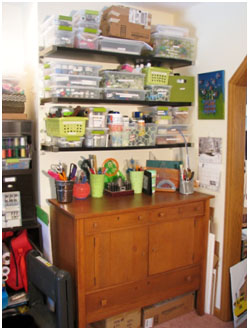 I have two design spaces for visualizing and piecing together ideas for new projects. The small portable one above my Bernina has a butterfly quilt on it right now. A larger flannel-backed tablecloth — secured by an IKEA hanging system — works for larger designs. I have a quilt designed by Nancy Rink hanging there now. I’m considering how to quilt it.
I have two design spaces for visualizing and piecing together ideas for new projects. The small portable one above my Bernina has a butterfly quilt on it right now. A larger flannel-backed tablecloth — secured by an IKEA hanging system — works for larger designs. I have a quilt designed by Nancy Rink hanging there now. I’m considering how to quilt it.
Last year I hung 3M Command hooks in strategic spots to keep small tools handy. No more digging through drawers for them!
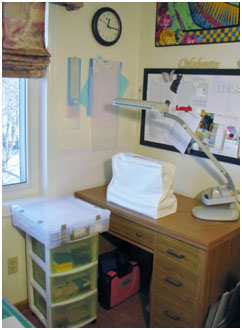 I have bookshelves for books, some of my class notebooks, finished quilt tops and my button collection. I have the most recent postcard art I’ve received on display for inspiration — the remainder are in my postcard box so they are portable to take out to share with others.
I have bookshelves for books, some of my class notebooks, finished quilt tops and my button collection. I have the most recent postcard art I’ve received on display for inspiration — the remainder are in my postcard box so they are portable to take out to share with others.
 Most of my fabric is in the fabric boxes on the shelves under my inspiration board and thimble collection. I try not to keep too much fabric on hand. Most of the time, I buy small amounts of fabrics. It is all I normally need for an Art Quilt. When I make a larger quilt, I usually buy only what I need, all at once.
Most of my fabric is in the fabric boxes on the shelves under my inspiration board and thimble collection. I try not to keep too much fabric on hand. Most of the time, I buy small amounts of fabrics. It is all I normally need for an Art Quilt. When I make a larger quilt, I usually buy only what I need, all at once.
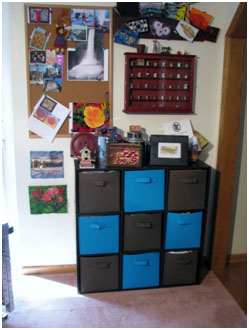 Two units are devoted to my longarm: a bookshelf houses supplies, rulers, bobbins,and tools and thread is in the drawers of a small cabinet with the bobbin winder on top.
Two units are devoted to my longarm: a bookshelf houses supplies, rulers, bobbins,and tools and thread is in the drawers of a small cabinet with the bobbin winder on top.
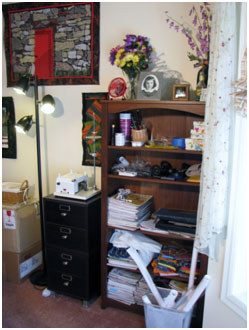 My desktop computer is quite old but it works well with the embroidery feature on my sewing machine. I can connect my sewing machine to my computer and download a pattern to embroider. I don’t use this a lot, but it’s fun! I would need to update my Bernina in order to use it with my new computer, so I keep my dinosaur around. There is always something to spend money on in the world of sewing and we have to pick and choose!
My desktop computer is quite old but it works well with the embroidery feature on my sewing machine. I can connect my sewing machine to my computer and download a pattern to embroider. I don’t use this a lot, but it’s fun! I would need to update my Bernina in order to use it with my new computer, so I keep my dinosaur around. There is always something to spend money on in the world of sewing and we have to pick and choose!
Do you have anything, supplies, more machines, etc. tucked away in any other rooms of the house?
I do have some of my messier supplies stored in the basement such as art supplies, dyeing supplies and polymer clay. I also have a room upstairs with some scrapbooking supplies. Many of these materials have multiple functions. There are more class notebooks in a cupboard in the family room.
How much horizontal surface do you have, and is it ever enough?
I don’t think quilters can ever have enough horizontal surfaces. For instance, the small cutting table on top of my IKEA cabinets works great for small projects but for large quilts I usually put a protective surface on the dining table or other large surface to work.
Do you have to move piles of stuff to cut anything bigger than a fat quarter? Do you straighten/organize as you go, putting each fabric away as you cut, or do you clean up after a project?
I answered this partially by admitting I move to another room to cut anything very large. I tend to pile as I work and keep everything out for a project until the project is finished, then I might put it away before I start the next project. Neatness, is not something I am known for in my family.
How many projects do you work on at once and how do you keep them organized?
I am usually working on 4 – 5 projects at once. For instance, I made Art Postcards, simultaneously, for two separate groups recently. I worked on both at once because they each had stages where they needed to dry for a day or two. At the same time, I made the pattern for the quilt I am preparing for Minnesota Contemporary Quilters, gathered the supplies to make a quilt for SAQA and started the butterfly quilt which is a challenge project for Minnesota Quilters.
I need to keep moving throughout the day. Sitting in one position too long creates problems for my back and neck which I injured in a car accident or I experience swelling in my left leg and foot where I have lymphedema. So, working on multiple projects helps to keep me moving. It also creates more mess!
Anything more you want to add about your studio, organization, working methods, etc., please do.
I like to get together with my friends to share ideas and learn new techniques. I also enjoy seeing how other people work and often adopt new techniques or organizational ideas for my own use. However, when it is time to make a project, I prefer to work alone. This helps me to focus on the task at hand and gives me some time to visualize new designs with a minimum of distractions.
Visit Janet’s blog
Next Month: Evie Harris


